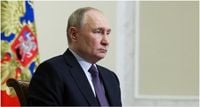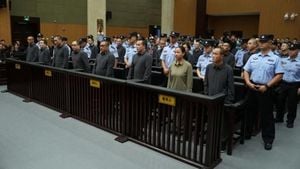On Monday, September 29, 2025, Russian President Vladimir Putin signed a decree ordering the conscription of 135,000 men for routine military service, marking the country’s largest autumn draft since 2016. This move, reported by Reuters, TASS, and other major outlets, underscores Moscow’s ongoing efforts to bolster its armed forces as the war in Ukraine drags on and military tensions remain high.
Under the new decree, Russian men aged 18 to 30 who are not in the military reserve will be called up for one year of mandatory service between October 1 and December 31, 2025. This autumn conscription, combined with the 160,000 men drafted during the spring campaign, brings the total number of conscripts for 2025 to the highest level in nearly a decade. By the end of the year, Russia will have drafted nearly 300,000 men—an increase that reflects both the scale of the ongoing conflict and the Kremlin’s commitment to maintaining one of the world’s largest standing armies.
Russia has long held biannual conscription drives, with the spring intake typically larger due to school and college graduations. According to The Moscow Times, the autumn 2016 intake saw 152,000 men conscripted, but since the full-scale invasion of Ukraine began in February 2022, the average autumn draft has hovered around 127,000. The current autumn drive, therefore, stands out not just for its size but also for the context in which it is taking place: a Russia increasingly on a war footing, with military spending and recruitment both surging.
Officially, conscripts are expected to serve at military bases inside Russia and are not supposed to be sent to the front lines in Ukraine. The Russian Defense Ministry and Kremlin have repeatedly insisted that the annual conscription campaigns are unrelated to wartime mobilization. Vladimir Tsimlyansky, head of the Russian General Staff’s mobilization department, recently stated that "conscripts will not be deployed to the forces currently invading Ukraine," a promise that Moscow has been accused of breaking in the past. Ukrainian officials have claimed to have captured Russian conscripts along the front lines, and President Putin himself admitted that some were mistakenly deployed early in the 2022 invasion.
The distinction between routine conscription and wartime mobilization is an important one in Russia. The biannual drafts are a long-standing tradition, enshrined in Russian law, and are separate from the mobilization orders that can be issued in times of war. However, as Reuters and The Moscow Times note, conscripts who have completed their initial year of training are more likely to be called up for combat duties in the future. This blurring of lines has fueled anxiety among Russian families and has led to widespread speculation about the true fate of many young draftees.
To meet the growing manpower demands, Russia is also moving to overhaul its conscription system. Last week, the State Duma passed a bill in its first reading that would eliminate the traditional biannual call-ups and replace them with a year-round draft starting next year. The aim, according to lawmakers, is to streamline the process and ensure a steady flow of recruits into the military. This legislative shift reflects the Kremlin’s determination to maintain a robust and flexible army as the conflict in Ukraine continues and as Russia seeks to project power on the global stage.
Beyond traditional conscription, Russia has also recruited hundreds of thousands of contract soldiers for its war in Ukraine, offering high salaries and generous sign-up bonuses to attract volunteers. According to The Moscow Times, these contract soldiers have become a crucial component of Moscow’s military strategy, supplementing the ranks of conscripts and providing experienced personnel for front-line operations. The Kremlin’s efforts to expand the military have been accompanied by a dramatic increase in defense spending, with levels now approaching those not seen since the Soviet era.
Putin’s ambitions for the Russian military are clear. In September 2024, he ordered the expansion of the armed forces to 1.5 million active personnel by 2026, a move that would give Russia one of the largest armies in the world. This build-up comes at a steep cost. The Center for Strategic and International Studies (CSIS), a Washington-based think tank, estimates that Moscow has suffered nearly one million casualties since the start of its full-scale invasion of Ukraine. About a quarter of those casualties are believed to be soldiers killed in battle—a figure five times greater than all Soviet and Russian losses in wars since World War II combined.
The scale of the losses and the relentless pace of recruitment have left deep scars on Russian society. Families worry about the fate of their sons, and questions swirl about the true nature of the country’s military commitments. According to AFP, the Russian government continues to insist that the annual drafts are routine and not connected to the war, but the reality on the ground appears more complicated. Reports of conscripts being sent to Ukraine, whether inadvertently or otherwise, have fueled ongoing debates about the ethics and legality of Russia’s recruitment policies.
Meanwhile, the Kremlin’s efforts to modernize and expand the military have prompted international concern. Western governments and human rights organizations have accused Moscow of using conscription as a tool to sustain its war in Ukraine, even as Russian officials maintain that all actions are within the bounds of national law. The move toward a year-round draft, in particular, has been seen by some analysts as a sign that Russia is preparing for a long-term conflict and is unwilling to scale back its military ambitions.
For now, the 135,000 men called up this autumn will report for duty at bases across Russia, joining a military apparatus that is larger and more active than at any time since the end of the Cold War. Whether they remain far from the front lines, as promised, or find themselves drawn into the conflict in Ukraine, remains to be seen. What is clear is that, under Putin’s leadership, Russia’s military continues to grow in both size and significance, shaping the country’s future and its place in a rapidly changing world.
As the year draws to a close and the new conscripts begin their service, the world will be watching closely to see how Russia’s evolving military strategy unfolds—and what it means for the ongoing war in Ukraine and for global security at large.




